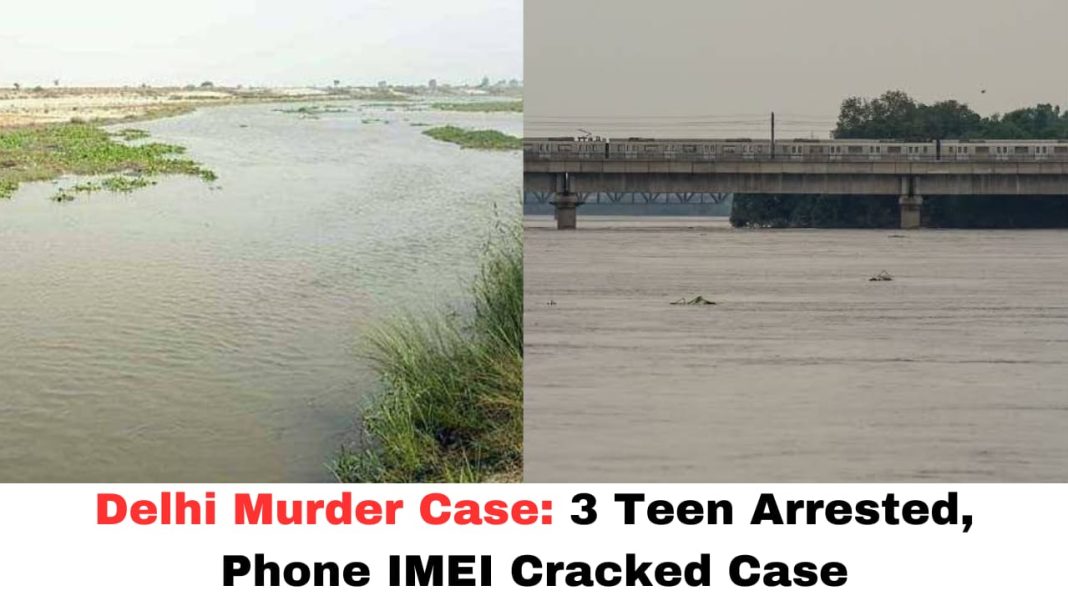Digital News Guru New Delhi Desk:
Three Teens Arrested in Delhi Over Murder Near Yamuna
What happened:
- On July 16, 2025, Delhi Police in Alipur flagged down three teenagers riding a stolen black motorcycle with no registration plate. While searching the teens, officers found a neon mobile phone that raised suspicions.
- During interrogation, the teens confessed to robbing and murdering 18‑year‑old Sonu Kumar, a labourer from Bihar’s Aurangabad district, near the Yamuna riverbank. They strangled him, performed a ritual of dipping his body in the river, and buried him in a 3-foot-deep pit between Shank No. 16 and 17.

Routine Delhi bike check leads to teen arrests in Yamuna murder
On the night of July 16, a police patrol in Outer North Delhi’s Alipur area intercepted three teenage boys riding a black motorcycle without license plates. When flagged, they attempted to flee but were swiftly overpowered. Routine searches revealed the bike was reported stolen on July 11 from the same vicinity.
As part of the search, officers found a neon-colored mobile phone in the possession of one of the teens. Its presence raised red flags — none of the boys could provide ownership details, receipts, or transaction records for it.
Confession and Skeleton Discovery
Under interrogation, the trio—each aged around 16—admitted they had forcibly taken the phone from a passing youth near the riverbank back in April, during which the victim resisted. In response, the boys confessed to strangling him to death.
Their story turned even more gruesome. To prevent recognition, they reportedly gouged out the victim’s eyes, then dipped his body in the Yamuna—a gesture they believed would help “his soul find peace”—before burying him in a three-foot deep grave between Shank Nos. 16 and 17 on the riverbank.
Police teams, escorted by the confessing minors, unearthed skeletal remains corresponding to the description provided. Forensic experts from the Forensic Science Laboratory, Rohini, and the Sub-Divisional Magistrate’s office supervised the excavation and collection of evidence.
IMEI Leads to Victim Identification
Critical to solving the case was the recovered phone’s Call Detail Records (CDR). Analysis revealed it hadn’t been used since mid-April, suggesting the victim had disappeared around that time. Through the phone’s IMEI number, police traced the device’s origin to Sonu Kumar, an 18‑year‑old labourer from Chandpur village, Aurangabad district, Bihar, who had moved to Delhi in March or April seeking work.
Sonu’s family confirmed his disappearance after contacting authorities. They had attempted to report him missing locally but were turned away, unaware he was in Delhi. DNA samples from Sonu’s family were sent for matching, and identification is expected to be confirmed shortly.

Legal Action Under Bharatiya Nyaya Sanhita
Delhi Police have registered a case at Alipur Police Station under the following sections of the Bharatiya Nyaya Sanhita (BNS):
- Section 103(1) – murder
- Section 238(A) – disappearance of evidence/giving false information
- Section 3(5) – common intention among offenders.
All three juvenile suspects remain in police custody. Investigative agencies plan to engage juvenile justice protocols appropriate for minors weighing such grave offenses.
Teenage Offenses and Expert Opinions
The involvement of minors aged approximately 16 in a case of such brutality has raised critical questions about juvenile crime, societal influences, and the handling of young offenders in India’s legal system. Criminal justice experts stress the urgent need for psychological counselling, rehabilitation, and strong deterrence to prevent repeat incidents.
Moreover, the case highlights a gap in missing-person protocols, especially between states. Sonu’s family reported him missing in Bihar but received no assistance, underscoring a need for better communication between state police forces via mechanisms like Interpoles or FIRO.
Public Safety & Policing – A Balanced Approach
The swift actions of the local police—initiated via a bike check—shed light on their vigilance. However, child rights advocates caution against overemphasizing punitive measures. They call for comprehensive support systems addressing youth neglect, unemployment, and inadequate supervision that may nudge marginalized teens toward crime.
A Somber Reminder
The tragic death of Sonu Kumar and the concealment of his remains on the shores of the Yamuna bring into stark focus deeper societal failings. His case isn’t just about teenage perpetration—it’s also about systemic gaps: failures in labor protection, missing person response delays, and the often-hidden violent potential among youth in urban spaces.
Immediate steps suggested by experts include:
- Inter-state missing-person mechanism improvement.
- Youth rehabilitation programs, especially in vulnerable communities.
- Enhanced juvenile justice training and infrastructure.
- Anti-snatching operations near vulnerable locations such as riverbanks and bus stops.

The Delhi Police may have cracked the case quickly, but much remains unresolved—especially the origins of the boys’ extreme violence and the absence of early intervention. As the case proceeds to court, the nation watches, waiting to understand how justice works when both victim and accused are at the threshold of adulthood.
Key Timeline
March–April 2025: Sonu arrives in Delhi; last phone activity
July 11: Motorcycle stolen from Alipur
July 16: Teens detained; confession leads to discovery of remains
July 17–18: Investigation underway, victim confirmed, charges filed
You May Also Read: Baksho Bondi – Shadowbox Chosen as IFFM 2025 Opening Night Film








